外研版(2024)九年级下册Module 1 Unit 3 Language in use Grammar课件(共34张PPT)
文档属性
| 名称 | 外研版(2024)九年级下册Module 1 Unit 3 Language in use Grammar课件(共34张PPT) | 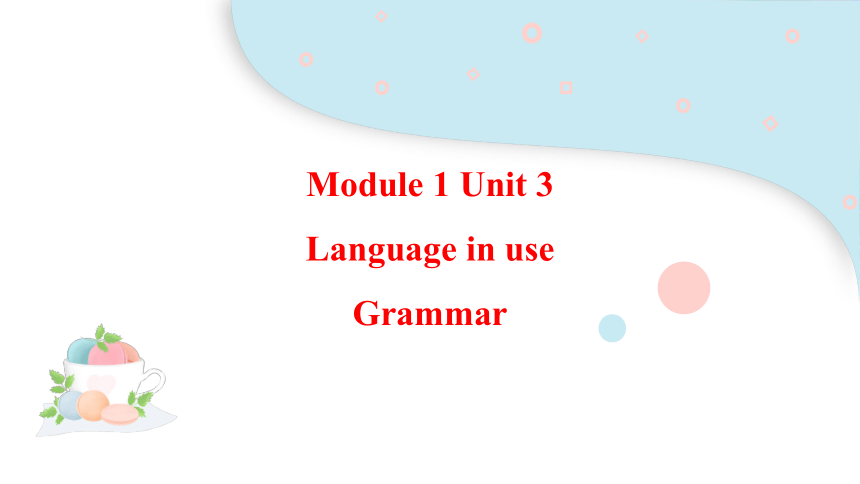 | |
| 格式 | pptx | ||
| 文件大小 | 2.7MB | ||
| 资源类型 | 教案 | ||
| 版本资源 | 外研版 | ||
| 科目 | 英语 | ||
| 更新时间 | 2025-04-27 20:11:39 | ||
图片预览


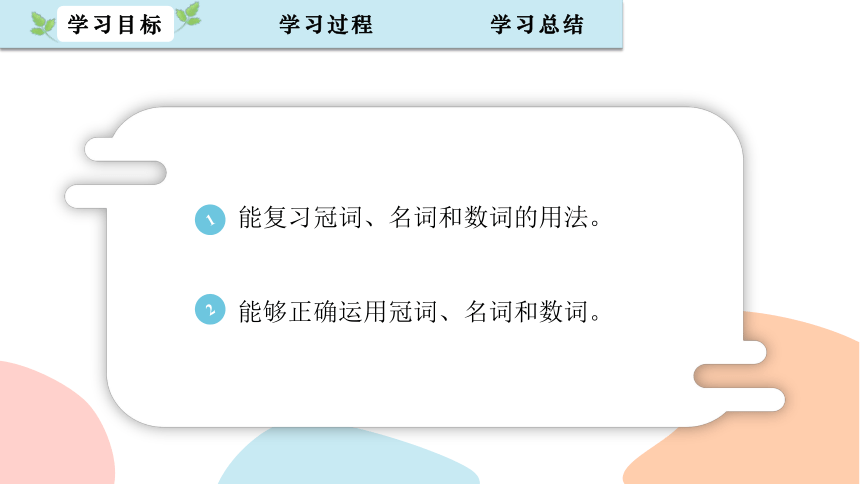
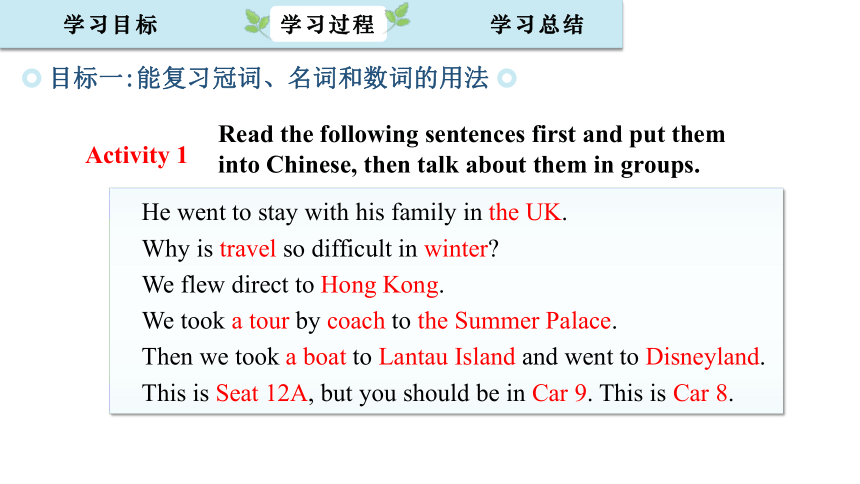





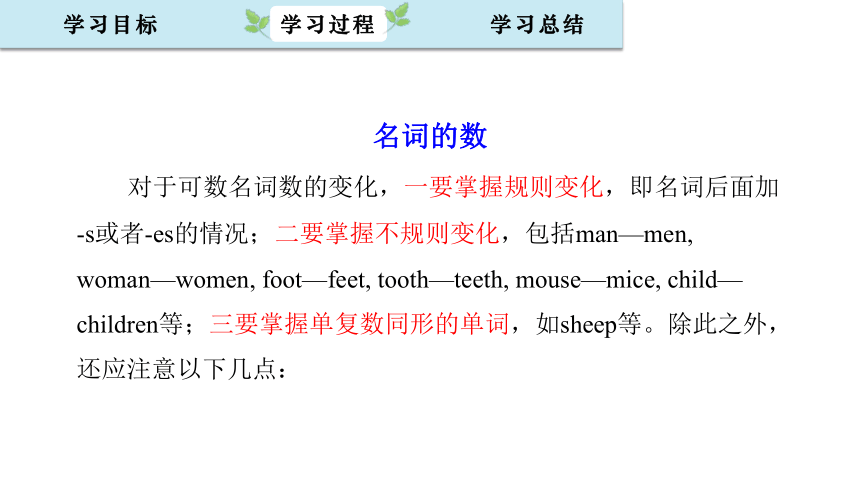
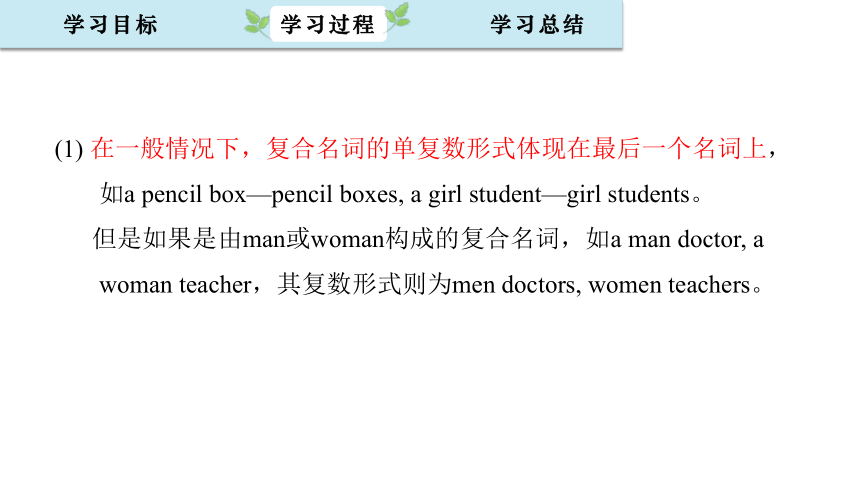

文档简介
(共34张PPT)
Module 1 Unit 3
Language in use
Grammar
Give me the first book.
圈出的单词分别是什么词性?
冠词
数词
名词
1
2
能复习冠词、名词和数词的用法。
能够正确运用冠词、名词和数词。
目标一:能复习冠词、名词和数词的用法
Activity 1
Read the following sentences first and put them
into Chinese, then talk about them in groups.
He went to stay with his family in the UK.
Why is travel so difficult in winter
We flew direct to Hong Kong.
We took a tour by coach to the Summer Palace.
Then we took a boat to Lantau Island and went to Disneyland.
This is Seat 12A, but you should be in Car 9. This is Car 8.
Group
Discussion
小组合作观察每个句子,讨论、总结并分组展示。
Task 1: 查阅相关资料复习总结名词的用法;
Task 2: 查阅相关资料复习总结冠词的用法;
Task 3: 查阅相关资料复习总结数词的用法。
He went to stay with his family in the UK.
Why is travel so difficult in winter
We flew direct to Hong Kong.
We took a tour by coach to the Summer Palace.
Then we took a boat to Lantau Island and went to Disneyland.
This is Seat 12A, but you should be in Car 9. This is Car 8.
Activity 2
每个小组派代表总结发言。
1 组
2 组
3 组
4 组
Activity 3
Summary
名词
名词有可数与不可数之分,有数和所有格的变化,在句中可以作主语、宾语、宾语补足语、表语、同位语等。
可数名词与不可数名词
很多情况下,可以依靠常识(即用数数的办法)来判断英语名词是否可数。比如,book, table 都是可数名词,而water是不可数名词。一般来说,在英语中物质名词和抽象名词都是不可数名词,如flour, rice, beauty, pleasure, money等。
学习名词必须区分其是否可数。只有可数名词前才可以使用数词和不定冠词。
值得注意的是,有时同一个单词所指不同,其数的概念也就不同。
例如,paper作“纸”解时为不可数名词,表示“报纸”和“试卷”时是可数名词;fish 指“鱼肉”时是不可数名词,表示“鱼”时是可数名词,只不过通常是单复数同形;coffee做“咖啡”解时是不可数名词,表示 “一杯咖啡”时是可数名词。
名词的数
对于可数名词数的变化,一要掌握规则变化,即名词后面加-s或者-es的情况;二要掌握不规则变化,包括man—men, woman—women, foot—feet, tooth—teeth, mouse—mice, child—children等;三要掌握单复数同形的单词,如sheep等。除此之外,还应注意以下几点:
(1) 在一般情况下,复合名词的单复数形式体现在最后一个名词上,如a pencil box—pencil boxes, a girl student—girl students。
但是如果是由man或woman构成的复合名词,如a man doctor, a woman teacher,其复数形式则为men doctors, women teachers。
(2) 有些名词往往以复数形式出现,如trousers, glasses(眼镜),在表示数量时需要借助量词,如a pair of trousers, three pairs of trousers。
(3) 有些名词表示复数概念,往往作为一个整体看待,如police, people。这些单词没有复数形式,但是其后面的谓语动词却多为复数形式。
例如:The police have caught the thief.
Many people have seen the film.
如果要表达单个数量只能换用其他单词。例如:“一名警察”是a policeman / a policewoman;“一个人”可以是a person, a man, a woman等。不过要注意,people作“民族,种族”解时,是可数名词,复数形式是peoples。
名词的所有格
名词的所有格一般采用名词后加’s的形式,如a child’s dream, someone’s bag;以-s结尾的复数名词的所有格直接加’即可,如the boys’ schoolbags。所有格表示的是所属关系,采用’s结构的多为有生命的名词。如果是无生命的名词,多采用 “of+名词” 的方式表达。
例如: the window of the house 房子的窗户
the end of the year 年末
the gate of our school 我们学校的大门
注意:a friend of my father’s与my father’s friend的含义不同,前者含有“我父亲有不止一个朋友”的意思,而后者没有这一含义。
名词的句法功能
名词的句法功能指名词可以充当的句子成分,常见的有:
(1) 主语
The flight takes about thirteen hours.
航程需要大约13个小时。
Mr. Wang teaches us English.
王老师教我们英语。
(2) 宾语
Many people were helping the old man when I passed.
我路过的时候,许多人在帮助这位老人。
He has become very interested in chess recently.
最近他对国际象棋产生了很大的兴趣。
(3) 宾语补足语
We all call him Xiao Li.
我们都叫他小李。
(4) 表语
My younger brother is a policeman.
我弟弟是警察。
(5) 名词还可以用作同位语、呼语等。如:
Mr. Wang, my neighbour, has bought a new car.
我的邻居王先生买了辆新车。
(my neighbour是Mr. Wang的同位语)
Tom, come and play games with us.
汤姆,来和我们玩游戏吧。(是呼语)
数词
对于数词,需掌握两点:基数词与序数词的表达方式;数词的基本用法。
基数词与序数词
注意基数词与序数词的不同写法,尤其要注意以下几组:
one—first; two—second; three—third;
four—fourth; fourteen—fourteenth;
forty—fortieth; five—fifth; eight—eighth;
nine—ninth; twelve—twelfth
数词的用法
数词可以在句子作定语、主语、宾语、状语等。
(1) 作定语
He has three children, and they all go to Park School.
他有三个孩子,都在帕克学校上学。
(2) 作主语
In this accident, four were killed and fifteen were badly wounded.
在这场事故中,4人丧生,15人重伤。
(3) 作宾语
He has eaten two eggs and I have eaten three.
他吃了两个鸡蛋,我吃了三个。 (第一个数词作定语,第二个数词作宾语)
(4) 作状语
First, open the book. Second, read the sentences.
首先打开书,然后读句子。
注意:hundred, thousand, million与数词连用时通常不带复数词尾-s,但若用于表示数百、数千、数百万这样的泛词概念时,则用复数。如:
two (several) hundred / thousand / million students
两(几)百/千/百万名学生(表示具体的数目)
hundreds / thousands / millions of students 几百/成千上万/数百万名学生(表示概数) 在以名词为中心,前面有冠词、数词以及形容词的结构中,这些词语的排列顺序为:
“冠词+数词+形容词+名词”。例如:the three little pigs。
分数表示法
用英语表达分数时,分子用基数词,分母用序数词。如果分子大于1,分母要用复数形式;如果分子等于1,分子可用a,也可用one。
注意:
(1) 表示“二分之一”,常用 a / one half;表示“四分之一”,用a / one fourth或a / one quarter;表示“四分之三”,用three fourths或three quarters。
(2) 当分数+名词作主语时,谓语动词的单复数取决于这个名词的意义。
冠词
冠词有三种, 一种是定冠词the, 另一种是不定冠词 a / an,还有一种是零冠词。
定冠词
1. 特指某(些)人或某(些)事物。
Pass me the apple, please.
2. 指谈话双方都知道的人或事物。
Where is the teacher
3. 复述上文提过的人或事物。
I have a beautiful wallet, but the wallet was stolen yesterday.
4. 世界上独一无二的事物(月亮、地球、天空、宇宙)等。
The sun rises in the east.
The earth goes round the sun.
5. 用在方位名词前。
in the south, in the west, in the north, in the east
6. 用在序数词或形容词最高级前。
The first thing I want to say is to listen carefully in class.
He is the tallest one in our class.
7. 表示两者间“较……的一个”时用定冠词。
He is the taller of the two boys.
8. 用在单数可数名词前表示一类人或事物。
The horse is a useful animal.
9. 定冠词用在形容词前, 表示一类人或东西。
the rich, the poor, the deaf, the wounded
10. 用在姓氏的复数形式前表示一家人或这夫妇二人。
The Browns went to Beijing last Sunday.
11. 在西洋乐器前加the。
the piano, the violin
12. 在人或物后有限定性的后置定语。
The man standing by the gate is Tom’s father.
13. 在世纪、年代等名词前用冠词。
in the 1980s或in the 1980’s
in the nineteenth century
14. 在固定短语中。
in the morning, in the afternoon
不定冠词
an, a是不定冠词, 表示“一”的意义, 但不强调数目时,仅用在单数可数名词前面。
a用在以辅音音素开头的词前, an用在以元音音素开头的词前, 如:a boy, an hour, a university, an elephant。
1. 表示人或事物的某一类。
A plane is a machine that can fly.
2. 表示某一类人或事物中的任何一个。
This is an apple.
3. 泛指某人或某物但不具体说明何人何物。
A man is waiting for you there.
4. 表示“一个”的意思。
My father will be back in a week.
5. 有时也表示“每”的意思。
We have three meals a day.
零冠词
1. 在物质名词、抽象名词前不用冠词。
The desk is made of wood.
2. 专有名词前不加冠词。
China, Beijing, Mary
3. 名词前有物主代词、指示代词、不定代词、名词所有格等修饰时不用冠词。
this, my, that, those, these, Tom’s
4. 月份、 星期、 季节前不用冠词。
on Sunday; in March; in summer
5. 在表示一类人或事物的复数名词前不用冠词。
Horses eat grass.
6. 在breakfast, lunch, supper三餐前不用冠词。如这些词前有形容词修饰可用不定冠词。
I have breakfast at seven every day.
I had a good lunch yesterday.
7. 在球类、棋类等名词前不用冠词。
He often plays football after school.
目标二:能够正确运用冠词、名词和数词
Activity 1
1
Complete the conversation with a, an, the or zero article where necessary.
A: I’m really looking forward to (1) ______ summer holiday. We’re
taking (2) ______ trip to (3) ______ Paris!
B: How wonderful! It’s (4) ______ interesting and beautiful city. How
long will (5) ______ flight take
A: The flight takes about (6) ______ hour. When we arrive, we will get to
our hotel by (7) ______ bus. (8) ______ hotel is right in (9) ______
centre of (10) ______ city , so we can visit all the famous places.
B: Are you planning to visit (11) ______ Louvre Museum
A: Yes, we are.
the
the
the
The
the
a
an
an
the
/
/
Activity 2
2
Underline the correct words.
1. Children have to go to school / the school when they are six years old.
2. I’m a teacher at school / the school on the corner.
3. He’s got a lovely garden. Flowers / The flowers in it are really beautiful.
4. Make sure you get to the airport in time / in the time for your plane.
5. —How many CDs have you got
—Only few / a few.
6. That’s most / the most interesting news I’ve heard for a long time.
7. How long have Whites / the Whites lived here
Activity 3
5
Listen and complete the notes.
London – Hong Kong: _______ hour(s)
Hong Kong – Sydney: _______ hour(s)
From airport to centre of Hong Kong:
_______ hour(s)
Price of flight: _______
Price of flight and hotel: _______
12
9
1
1,199
1,247
London to Sydney
Sydney to London
Sydney – London: _______ hour(s)
Price of flight: _______
Price of flight and hotel near airport: _______
From airport to centre of Sydney: ________ kilometres
24
1,119
1,189
20
6
Work in pairs. Look at the notes you have made in Activity 5. Talk about:
Which flight takes a longer time
Which flight is more expensive
综合上述目标,说说我们今天的收获。
学习目标
1
2
能复习冠词、名词和数词的用法。
能够正确运用冠词、名词和数词。
Module 1 Unit 3
Language in use
Grammar
Give me the first book.
圈出的单词分别是什么词性?
冠词
数词
名词
1
2
能复习冠词、名词和数词的用法。
能够正确运用冠词、名词和数词。
目标一:能复习冠词、名词和数词的用法
Activity 1
Read the following sentences first and put them
into Chinese, then talk about them in groups.
He went to stay with his family in the UK.
Why is travel so difficult in winter
We flew direct to Hong Kong.
We took a tour by coach to the Summer Palace.
Then we took a boat to Lantau Island and went to Disneyland.
This is Seat 12A, but you should be in Car 9. This is Car 8.
Group
Discussion
小组合作观察每个句子,讨论、总结并分组展示。
Task 1: 查阅相关资料复习总结名词的用法;
Task 2: 查阅相关资料复习总结冠词的用法;
Task 3: 查阅相关资料复习总结数词的用法。
He went to stay with his family in the UK.
Why is travel so difficult in winter
We flew direct to Hong Kong.
We took a tour by coach to the Summer Palace.
Then we took a boat to Lantau Island and went to Disneyland.
This is Seat 12A, but you should be in Car 9. This is Car 8.
Activity 2
每个小组派代表总结发言。
1 组
2 组
3 组
4 组
Activity 3
Summary
名词
名词有可数与不可数之分,有数和所有格的变化,在句中可以作主语、宾语、宾语补足语、表语、同位语等。
可数名词与不可数名词
很多情况下,可以依靠常识(即用数数的办法)来判断英语名词是否可数。比如,book, table 都是可数名词,而water是不可数名词。一般来说,在英语中物质名词和抽象名词都是不可数名词,如flour, rice, beauty, pleasure, money等。
学习名词必须区分其是否可数。只有可数名词前才可以使用数词和不定冠词。
值得注意的是,有时同一个单词所指不同,其数的概念也就不同。
例如,paper作“纸”解时为不可数名词,表示“报纸”和“试卷”时是可数名词;fish 指“鱼肉”时是不可数名词,表示“鱼”时是可数名词,只不过通常是单复数同形;coffee做“咖啡”解时是不可数名词,表示 “一杯咖啡”时是可数名词。
名词的数
对于可数名词数的变化,一要掌握规则变化,即名词后面加-s或者-es的情况;二要掌握不规则变化,包括man—men, woman—women, foot—feet, tooth—teeth, mouse—mice, child—children等;三要掌握单复数同形的单词,如sheep等。除此之外,还应注意以下几点:
(1) 在一般情况下,复合名词的单复数形式体现在最后一个名词上,如a pencil box—pencil boxes, a girl student—girl students。
但是如果是由man或woman构成的复合名词,如a man doctor, a woman teacher,其复数形式则为men doctors, women teachers。
(2) 有些名词往往以复数形式出现,如trousers, glasses(眼镜),在表示数量时需要借助量词,如a pair of trousers, three pairs of trousers。
(3) 有些名词表示复数概念,往往作为一个整体看待,如police, people。这些单词没有复数形式,但是其后面的谓语动词却多为复数形式。
例如:The police have caught the thief.
Many people have seen the film.
如果要表达单个数量只能换用其他单词。例如:“一名警察”是a policeman / a policewoman;“一个人”可以是a person, a man, a woman等。不过要注意,people作“民族,种族”解时,是可数名词,复数形式是peoples。
名词的所有格
名词的所有格一般采用名词后加’s的形式,如a child’s dream, someone’s bag;以-s结尾的复数名词的所有格直接加’即可,如the boys’ schoolbags。所有格表示的是所属关系,采用’s结构的多为有生命的名词。如果是无生命的名词,多采用 “of+名词” 的方式表达。
例如: the window of the house 房子的窗户
the end of the year 年末
the gate of our school 我们学校的大门
注意:a friend of my father’s与my father’s friend的含义不同,前者含有“我父亲有不止一个朋友”的意思,而后者没有这一含义。
名词的句法功能
名词的句法功能指名词可以充当的句子成分,常见的有:
(1) 主语
The flight takes about thirteen hours.
航程需要大约13个小时。
Mr. Wang teaches us English.
王老师教我们英语。
(2) 宾语
Many people were helping the old man when I passed.
我路过的时候,许多人在帮助这位老人。
He has become very interested in chess recently.
最近他对国际象棋产生了很大的兴趣。
(3) 宾语补足语
We all call him Xiao Li.
我们都叫他小李。
(4) 表语
My younger brother is a policeman.
我弟弟是警察。
(5) 名词还可以用作同位语、呼语等。如:
Mr. Wang, my neighbour, has bought a new car.
我的邻居王先生买了辆新车。
(my neighbour是Mr. Wang的同位语)
Tom, come and play games with us.
汤姆,来和我们玩游戏吧。(是呼语)
数词
对于数词,需掌握两点:基数词与序数词的表达方式;数词的基本用法。
基数词与序数词
注意基数词与序数词的不同写法,尤其要注意以下几组:
one—first; two—second; three—third;
four—fourth; fourteen—fourteenth;
forty—fortieth; five—fifth; eight—eighth;
nine—ninth; twelve—twelfth
数词的用法
数词可以在句子作定语、主语、宾语、状语等。
(1) 作定语
He has three children, and they all go to Park School.
他有三个孩子,都在帕克学校上学。
(2) 作主语
In this accident, four were killed and fifteen were badly wounded.
在这场事故中,4人丧生,15人重伤。
(3) 作宾语
He has eaten two eggs and I have eaten three.
他吃了两个鸡蛋,我吃了三个。 (第一个数词作定语,第二个数词作宾语)
(4) 作状语
First, open the book. Second, read the sentences.
首先打开书,然后读句子。
注意:hundred, thousand, million与数词连用时通常不带复数词尾-s,但若用于表示数百、数千、数百万这样的泛词概念时,则用复数。如:
two (several) hundred / thousand / million students
两(几)百/千/百万名学生(表示具体的数目)
hundreds / thousands / millions of students 几百/成千上万/数百万名学生(表示概数) 在以名词为中心,前面有冠词、数词以及形容词的结构中,这些词语的排列顺序为:
“冠词+数词+形容词+名词”。例如:the three little pigs。
分数表示法
用英语表达分数时,分子用基数词,分母用序数词。如果分子大于1,分母要用复数形式;如果分子等于1,分子可用a,也可用one。
注意:
(1) 表示“二分之一”,常用 a / one half;表示“四分之一”,用a / one fourth或a / one quarter;表示“四分之三”,用three fourths或three quarters。
(2) 当分数+名词作主语时,谓语动词的单复数取决于这个名词的意义。
冠词
冠词有三种, 一种是定冠词the, 另一种是不定冠词 a / an,还有一种是零冠词。
定冠词
1. 特指某(些)人或某(些)事物。
Pass me the apple, please.
2. 指谈话双方都知道的人或事物。
Where is the teacher
3. 复述上文提过的人或事物。
I have a beautiful wallet, but the wallet was stolen yesterday.
4. 世界上独一无二的事物(月亮、地球、天空、宇宙)等。
The sun rises in the east.
The earth goes round the sun.
5. 用在方位名词前。
in the south, in the west, in the north, in the east
6. 用在序数词或形容词最高级前。
The first thing I want to say is to listen carefully in class.
He is the tallest one in our class.
7. 表示两者间“较……的一个”时用定冠词。
He is the taller of the two boys.
8. 用在单数可数名词前表示一类人或事物。
The horse is a useful animal.
9. 定冠词用在形容词前, 表示一类人或东西。
the rich, the poor, the deaf, the wounded
10. 用在姓氏的复数形式前表示一家人或这夫妇二人。
The Browns went to Beijing last Sunday.
11. 在西洋乐器前加the。
the piano, the violin
12. 在人或物后有限定性的后置定语。
The man standing by the gate is Tom’s father.
13. 在世纪、年代等名词前用冠词。
in the 1980s或in the 1980’s
in the nineteenth century
14. 在固定短语中。
in the morning, in the afternoon
不定冠词
an, a是不定冠词, 表示“一”的意义, 但不强调数目时,仅用在单数可数名词前面。
a用在以辅音音素开头的词前, an用在以元音音素开头的词前, 如:a boy, an hour, a university, an elephant。
1. 表示人或事物的某一类。
A plane is a machine that can fly.
2. 表示某一类人或事物中的任何一个。
This is an apple.
3. 泛指某人或某物但不具体说明何人何物。
A man is waiting for you there.
4. 表示“一个”的意思。
My father will be back in a week.
5. 有时也表示“每”的意思。
We have three meals a day.
零冠词
1. 在物质名词、抽象名词前不用冠词。
The desk is made of wood.
2. 专有名词前不加冠词。
China, Beijing, Mary
3. 名词前有物主代词、指示代词、不定代词、名词所有格等修饰时不用冠词。
this, my, that, those, these, Tom’s
4. 月份、 星期、 季节前不用冠词。
on Sunday; in March; in summer
5. 在表示一类人或事物的复数名词前不用冠词。
Horses eat grass.
6. 在breakfast, lunch, supper三餐前不用冠词。如这些词前有形容词修饰可用不定冠词。
I have breakfast at seven every day.
I had a good lunch yesterday.
7. 在球类、棋类等名词前不用冠词。
He often plays football after school.
目标二:能够正确运用冠词、名词和数词
Activity 1
1
Complete the conversation with a, an, the or zero article where necessary.
A: I’m really looking forward to (1) ______ summer holiday. We’re
taking (2) ______ trip to (3) ______ Paris!
B: How wonderful! It’s (4) ______ interesting and beautiful city. How
long will (5) ______ flight take
A: The flight takes about (6) ______ hour. When we arrive, we will get to
our hotel by (7) ______ bus. (8) ______ hotel is right in (9) ______
centre of (10) ______ city , so we can visit all the famous places.
B: Are you planning to visit (11) ______ Louvre Museum
A: Yes, we are.
the
the
the
The
the
a
an
an
the
/
/
Activity 2
2
Underline the correct words.
1. Children have to go to school / the school when they are six years old.
2. I’m a teacher at school / the school on the corner.
3. He’s got a lovely garden. Flowers / The flowers in it are really beautiful.
4. Make sure you get to the airport in time / in the time for your plane.
5. —How many CDs have you got
—Only few / a few.
6. That’s most / the most interesting news I’ve heard for a long time.
7. How long have Whites / the Whites lived here
Activity 3
5
Listen and complete the notes.
London – Hong Kong: _______ hour(s)
Hong Kong – Sydney: _______ hour(s)
From airport to centre of Hong Kong:
_______ hour(s)
Price of flight: _______
Price of flight and hotel: _______
12
9
1
1,199
1,247
London to Sydney
Sydney to London
Sydney – London: _______ hour(s)
Price of flight: _______
Price of flight and hotel near airport: _______
From airport to centre of Sydney: ________ kilometres
24
1,119
1,189
20
6
Work in pairs. Look at the notes you have made in Activity 5. Talk about:
Which flight takes a longer time
Which flight is more expensive
综合上述目标,说说我们今天的收获。
学习目标
1
2
能复习冠词、名词和数词的用法。
能够正确运用冠词、名词和数词。
同课章节目录
- Module 1 Travel
- Unit 1 We toured the city by bus and by taxi
- Unit 2 It's a long story.
- Unit 3 Language in use
- Module 2 Education
- Unit 1 They don't sit in rows.
- Unit 2 What do I like best about school?
- Unit 3 Language in use
- Module 3 Life now and then
- Unit 1 They sometimes work harder.
- Unit 2 I think life is better today.
- Unit 3 Language in use.
- Module 4 Rules and suggestions
- Unit 1 You must be careful of falling stones.
- Unit 2 we must keep the camp clean.
- Unit 3 Language in use.
- Revison A
- Module 5 Look after yourself
- Unit 1 We'd better get you to hospital.
- Unit 2 Get off the sofa!
- Unit 3 Language in use.
- Module 6 Eating togethe
- Unit 1 When is the school-leavers' party?
- Unit 2 Knives and forks are used for most Western
- Unit 3 Language in use
- Module 7 English for you and me
- Unit 1 Have you ever been to an English corner?
- Unit 2 We all own English.
- Unit 3 Language in use
- Module 8 My future life
- Unit 1 Here's to our friendship and the future
- Unit 2 I know that you will be better at maths.
- Unit 3 Language in use
- Revison B
